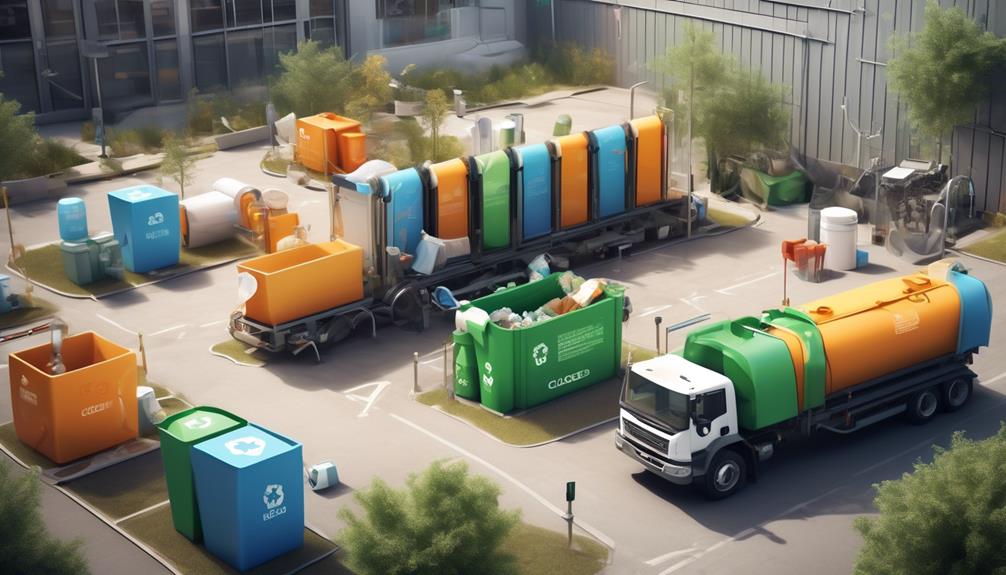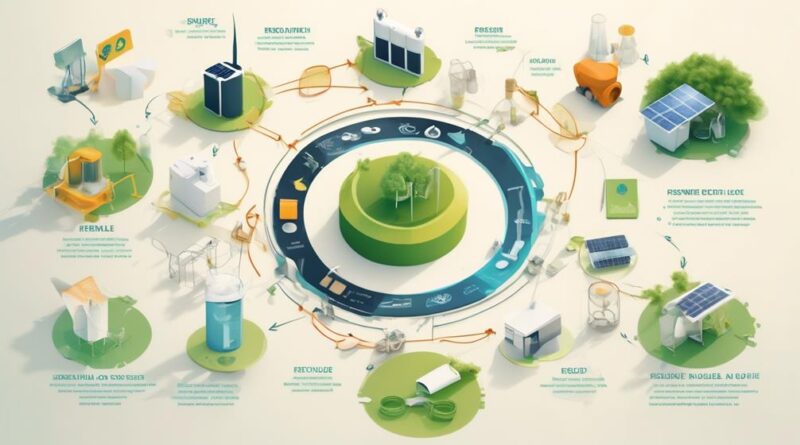15 Ways Circular Economy Reduces Waste
You probably don't realize just how much impact a circular economy can have on reducing waste. From extending product lifespan to promoting reuse and repair, there are numerous ways in which this approach can make a significant difference.
The 15 strategies we'll explore are not only practical but also essential for tackling the global waste crisis. Whether you're a business owner, consumer, or simply curious about sustainable practices, understanding these methods is crucial for navigating the future of resource management.
Extending Product Lifespan
To reduce waste and promote sustainability, consider ways to extend the lifespan of your products through repair and maintenance. By utilizing repair workshops and the second-hand market, you can significantly prolong the life of your belongings and contribute to a circular economy.
When your products break or show signs of wear and tear, instead of discarding them, consider taking them to repair workshops. These workshops are equipped with skilled professionals who can fix a wide range of items, from electronics and appliances to clothing and furniture. By getting your products repaired, you not only save money compared to buying new items but also prevent them from ending up in landfills.
Additionally, consider exploring the second-hand market when you're in need of a new item or looking to replace something old. Many pre-owned products still have plenty of life left in them and can be purchased at a fraction of the cost of a new item. By buying second-hand, you're giving these products a new lease on life and reducing the demand for new manufacturing, which in turn helps to conserve resources and energy.
Promoting Reuse and Repair
Consider exploring local repair workshops and the second-hand market to actively promote reuse and repair of your products, contributing to a circular economy and waste reduction. Repair workshops offer a valuable resource for fixing and refurbishing items that might otherwise be discarded. By engaging with these workshops, you not only extend the lifespan of your possessions but also support local businesses and skilled artisans.
Additionally, participating in reuse initiatives such as swapping events or second-hand markets can provide a new home for items you no longer need, further preventing them from becoming waste.
Repair workshops can range from specialized facilities for electronics or appliances to community-driven spaces where individuals can learn repair skills and work on various items. Participating in or organizing repair workshops within your community can foster a culture of resourcefulness and sustainability.
Furthermore, supporting reuse initiatives like second-hand markets not only gives your belongings a second life but also reduces the demand for new products, ultimately lessening the environmental impact associated with manufacturing and transportation.
Shifting to Renewable Resources
By gradually integrating renewable resources into your daily operations, you can significantly reduce your reliance on non-renewable sources and contribute to a more sustainable and circular economy. Renewable energy sources such as solar, wind, and hydroelectric power offer a cleaner and more sustainable alternative to traditional non-renewable resources. Embracing renewable energy allows you to reduce your carbon footprint and minimize environmental impact while promoting sustainable production methods.
Shifting to renewable resources involves transitioning from fossil fuels to renewable energy sources. This shift can be achieved through installing solar panels, utilizing wind turbines, and investing in energy-efficient technologies. By harnessing renewable energy, you not only decrease your dependence on finite resources but also contribute to the overall reduction of greenhouse gas emissions. This transition not only benefits the environment but also supports the development of a more resilient and efficient energy infrastructure.
In addition to renewable energy, embracing sustainable production practices is crucial in reducing waste and promoting circular economy principles. This involves adopting eco-friendly materials, implementing efficient manufacturing processes, and prioritizing waste reduction and recycling initiatives. By incorporating sustainable production methods, you can minimize resource consumption and decrease the generation of non-recyclable waste, ultimately contributing to a more sustainable and circular economy.
Reducing Material Waste
Embracing efficient material usage and waste reduction practices is essential for fostering a circular economy and promoting sustainable production methods. Reducing material waste involves implementing innovative strategies and processes to maximize the use of resources and minimize the generation of waste. Here are some key approaches to reducing material waste:
- Upcycling Innovation: Encouraging the development of innovative technologies and processes that transform waste materials into new products or materials. This not only reduces the amount of waste sent to landfills but also creates new value from materials that would have otherwise been discarded.
- Waste Audits and Tracking: Conducting regular waste audits to identify areas where material waste can be reduced and implementing systems to track and monitor material usage throughout the production process. This allows for better management of resources and reduction of unnecessary waste.
- Design for Disassembly: Implementing design principles that make it easier to disassemble products at the end of their lifecycle, enabling the recovery and reuse of components and materials. This approach promotes a more circular flow of materials within the economy.
- Resource Efficiency Training: Providing training and education to employees on resource-efficient practices and waste reduction strategies. This empowers staff to identify opportunities for reducing material waste and implementing sustainable practices in their daily work.
Implementing Sustainable Design
To promote sustainable production methods and foster a circular economy, it's crucial to integrate sustainable design practices that prioritize resource efficiency and minimize environmental impact. Implementing sustainable design involves adopting sustainable manufacturing processes and utilizing eco-friendly materials.
Sustainable manufacturing focuses on reducing energy consumption, minimizing waste, and decreasing the overall environmental footprint of production. This can be achieved through the use of renewable energy sources, such as solar or wind power, as well as implementing energy-efficient technologies and processes.
In addition to sustainable manufacturing, the use of eco-friendly materials is essential in sustainable design. These materials are sourced and produced in ways that have minimal impact on the environment. They're often renewable, recyclable, or biodegradable, and they contribute to the overall reduction of waste in the production and consumption cycle.
Incorporating eco-friendly materials into product design not only reduces environmental impact but also supports the development of a more sustainable supply chain.
Embracing Product-as-a-Service Models
Emphasizing the shift towards a more sustainable approach, integrating product-as-a-service models can revolutionize the way resources are utilized and contribute to a more circular economy.
By embracing collaborative consumption and shared ownership, individuals and businesses can make more efficient use of products and materials, reducing waste and environmental impact. The subscription economy and rental services offer opportunities to access goods as needed, promoting a less wasteful and more sustainable lifestyle.
Embracing product-as-a-service models can bring about a range of benefits, including:
- Resource Optimization: Shared ownership and collaborative consumption enable multiple users to make use of a single product, maximizing its lifespan and minimizing the overall resources required for production.
- Waste Reduction: By promoting the use of rental services and subscription-based models, product-as-a-service approaches can significantly reduce the amount of waste generated from single-use items and unnecessary consumption.
- Economic Efficiency: These models can lead to cost savings for consumers, as they only pay for the actual usage of a product rather than owning it outright, while also allowing businesses to optimize their resource allocation.
- Environmental Conservation: Embracing product-as-a-service models supports a more sustainable and environmentally conscious lifestyle, as it encourages the reuse and sharing of products, ultimately reducing the environmental impact of manufacturing and disposal processes.
Fostering Resource Efficiency

You can achieve resource efficiency by closely monitoring and optimizing your consumption patterns and material usage. This involves maximizing the value derived from resources while minimizing their impact on the environment. One way to foster resource efficiency is by implementing sustainable practices such as reducing, reusing, and recycling materials. By doing so, you can minimize waste and conserve resources, ultimately contributing to a more circular economy.
Another important aspect of fostering resource efficiency is the adoption of eco-friendly production processes. This involves using renewable energy sources, optimizing manufacturing techniques to reduce material waste, and implementing efficient water and energy management systems. By maximizing resource efficiency in production, you can reduce the environmental impact of manufacturing processes while simultaneously cutting costs.
Furthermore, embracing innovative technologies and materials can also foster resource efficiency. For instance, utilizing advanced materials that are durable, recyclable, and resource-efficient can significantly reduce the overall environmental footprint of products. Additionally, leveraging digital technologies such as data analytics and artificial intelligence can help optimize resource usage and minimize waste across various industries.
Encouraging Recycling Ecosystem
Encouraging the development of a robust recycling ecosystem is crucial for promoting sustainability and minimizing waste. In order to achieve this, several key strategies can be implemented:
- Incentivizing Collaboration: By offering incentives to businesses and communities for participating in recycling programs, there's a greater likelihood of increasing recycling rates. This can be achieved through tax incentives, grants, or subsidies for organizations that actively engage in recycling initiatives.
- Enhancing Infrastructure: Developing and improving recycling infrastructure, such as recycling facilities and collection systems, is essential for creating a more efficient and accessible recycling ecosystem. This includes investing in advanced technology for sorting and processing recyclable materials, as well as expanding the reach of recycling collection services to make it more convenient for individuals and businesses to participate.
- Promoting Education and Awareness: Educating the public about the importance of recycling and the impact of waste on the environment can help foster a culture of responsible consumption and disposal. This can be done through educational campaigns, school programs, and community outreach efforts.
- Implementing Extended Producer Responsibility (EPR) Programs: EPR programs require manufacturers to take responsibility for the entire lifecycle of their products, including recycling and disposal. By implementing EPR programs, manufacturers are incentivized to design products that are easier to recycle and are responsible for managing the recycling process, thereby reducing the burden on local waste management systems.
Frequently Asked Questions
How Can Circular Economy Principles Be Applied to the Fashion Industry to Reduce Waste?
To reduce waste in the fashion industry, apply circular economy principles by using sustainable materials and designing products for reuse. Emphasize recycling and repurposing to create a system that minimizes environmental impact and promotes sustainability.
What Are the Potential Challenges in Implementing Product-As-A-Service Models in Different Industries?
Implementing product-as-a-service models in different industries may face challenges like regulatory barriers and the need for a mindset shift. Adoption barriers could include concerns about ownership and changes in traditional business models.
How Can Businesses Incentivize Customers to Participate in the Recycling Ecosystem?
To incentivize customers in the recycling ecosystem, businesses can create incentive programs and focus on consumer education. By offering rewards for recycling and educating consumers on the benefits, businesses can encourage active participation in the recycling process.
Are There Any Examples of Successful Partnerships Between Businesses and Local Communities to Promote Reuse and Repair Initiatives?
Successful partnerships between businesses and local communities promote reuse and repair initiatives through collaboration and community engagement. By working together, businesses and communities can create impactful solutions that benefit both the environment and local residents.
What Are Some Innovative Ways That Companies Are Shifting to Renewable Resources in Their Production Processes?
You're seeing companies shift to renewable materials and sustainable production techniques. They're using plant-based plastics, recycled metals, and energy-efficient processes. By embracing these innovations, businesses are reducing waste and lessening their environmental impact.
Conclusion
So, as you can see, embracing a circular economy has numerous benefits when it comes to reducing waste. By extending product lifespan, promoting reuse and repair, and shifting to renewable resources, we can make a significant impact on reducing material waste and promoting sustainability.
By implementing these 15 ways, we can work towards a more efficient and responsible use of resources, ultimately leading to a healthier and more sustainable future for all.
